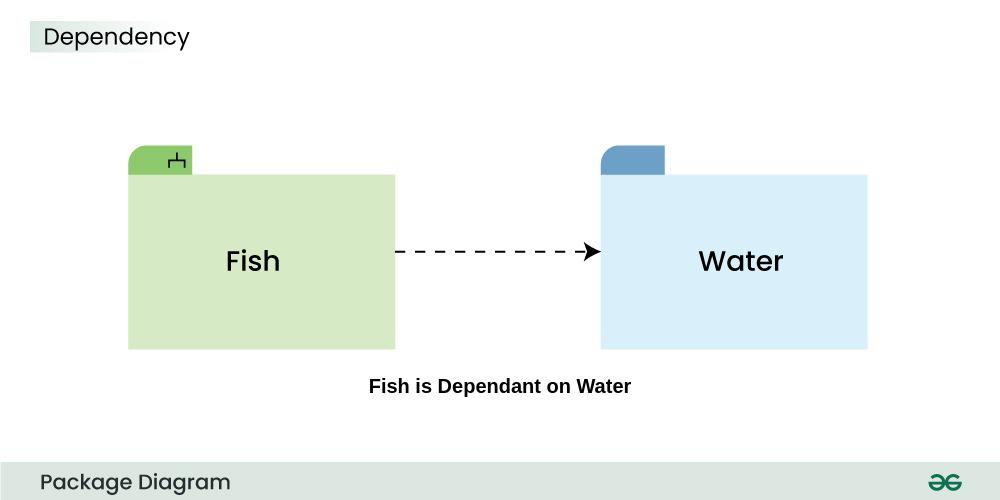Package Diagram | Introduction, Elements, Use Cases and Benefits
Last Updated :
22 Jan, 2024
A package diagram is a type of Unified Modeling Language (UML) diagram mainly used to represent the organization and the structure of a system in the form of packages.

A package is used as a container to organize the elements present in the system into a more manageable unit. It is very useful to represent the system’s architecture and design as a cohesive unit and a concise manner.
Important Topics for Package Diagram
1. Basic Elements of Package Diagrams
The following are the basic elements of a Package Diagrams:

- Package: This basic building block of the Package Diagram is a Package. It is a container for organizing different diagram elements such as classes, interfaces, etc. It is represented in the Diagram in a folder-like icon with its name.
- NameSpace: It represents the package’s name in the diagram. It generally appears on top of the package symbol which helps to uniquely identify the package in the diagram.
- Package Merge: It is a relationship that signifies how a package can be merged or combined. It is represented as a direct arrow between two packages. Signifying that the contents of one package can be merged with the contents of the other.
- Package Import: It is another relationship that shows one package’s access to the contents of a different package. It is represented as a Dashed Arrow.
- Dependency: Dependencies are used to show that there might be some element or package that can be dependent upon any other element or package, meaning that changing anything of that package will result in alteration of the contents of the other package which is dependent upon the first one.
- Element: An element can be a single unit inside of a package, it can be a class, an interface or subsystems. This packages are connected and reside inside of packages that hold them.
- For example, if we consider a Class, then there can be many functions inside it and many variables or subclass can also be present, all of these are considered as an Element of that Class and they are connected with the Main Class, without the existence of the main class, they will also not exist or have no relevance.
- Constraint: It is like a condition or requirement set related to a package. It is represented by curly braces.
2. Package Structure and Notation
2.1 Package

The above is the notation of a simple Package.
2.2 Subsystem

The above notation is used to represent subsystem.
2.3 Dependency

The above dashed arrow sign is used to show the dependency among two elements or two packages.
2.4 Import

The above notation is of the Import, here it also uses a dashed arrow line but the difference is, the word <<import>> is being written to represent the below package or function or element has been imported from the above package.
2.5 Merge

This notation above denotes that the Package 1 can be merged with Package 2
3. Package Relationships
3.1 Package Merge Relationship
This relationship is used to represent that the contents of a package can be merged with the contents of another package. This implies that the source and the target package has some elements common in them, so that they can be merged together.
Example:

The above diagram depicts that the packages are of different type of payments, but all of them are a some kind of payment mechanism, so they can all be merged to be called as payment.
3.2 Package Dependency Relationship
A package can be dependant on other different packages, signifying that the source package is somehow dependent on the target package.
Example:

The above diagram depicts that the online payment package is dependent on the Internet package and uses “need” dependency.
3.3 Package Import Relationship
This relationship is used to represent that a package is importing another package to use. It signifies that the importing package can access the public contents of the imported package.
Example:

The above package diagram shows the import relationship between the main package Shapes and it’s various other sub packages Square, Rectangle etc. They all are importing the real Shapes package so that the public contents of the Shapes package can be used by them.
3.4 Package Access Relationship
This type of relationship signifies that there is a access relationship between two or more packages, meaning that one package can access the contents of another package without importing it.
Example:

The above diagram depicts the Access relationship between the Front End and Back End services. It is much needed that a front end service can easily access the important Back End services to carry out any operation.
4. Use Cases of Package Diagrams
Package Diagram is an essential part of System Design, it is a versatile tool to model and depict the structure of any organization or system’s elements. Some of the use cases of Package Diagrams are listed below:
- System Structure Visualization: Package Diagram is helpful to represent the system’s structure in a diagrammatic format. It also helps in organizing the elements into smaller and compact packages. This type of visualization help in understanding the structure of the system in a more concise manner.
- Module and Component Managemen: Package Diagram is useful to organize and manage modules or components within a system. Package acts as a container for items which are related to each other. It helps in grouping and categorizing parts of the system.
- Dependency Managemen: Developers use Package Diagram to represent dependency between the different packages, this is useful to represent the system’s architecture neatly and show the potential impact of the changes.
- System Decomposition: System Architects tend to break down a complex problem into a group of smaller and easily managable problem at the initial stage of the System Design. This helps in designing the components easier and easier implementation.
- Versioning and Release Planning: Project Managers often use Package Diagram to plan release of the product, ensuring that all the newly added components and changes are well understood and coordinated.
5. Package Diagram Best Practices
Below are some of the best practices to be followed in case of a Package Diagram:
- Clearly Define the Package Names: It is always recommended to clearly define the package names in such a manner that there is no duplicate present in the same package which might create confusion.
- Organize Packages Hierarchically: Organize the packages in a hierarchical manner so that it represents the proper structure of the system and the relationship of the various parts of the system.
- Maintain Modularity: Make the packages concise, use a single package to represent a single function or element. Don’t use overcomplicated and complex packages.
- Document Dependencies: Clearly mention and document the dependencies between the packages using the suitable symbols .This includes dependencies such as associations, generalizations, or dependencies.
- Use Colors and Styles Sparingly: Use different colors and styles to differentiate between different packages, but ensure the used colors are meaningful and consistent.
6. Benefits of Package Diagram
- Clarity and Understanding: It provides a visual representation of the system’s architecture, showing that how each elements are organized and interact with each other.
- Modularity and Encapsulation: Package Diagram encourages a modular approach to represent any system in form of smaller and easy to understand packages. It also supports the encapsulation of elements into packages which share a same trait.
- Communication and Collaboration: It servers as a common language of commmunication between the developers and the stakeholders.
- Dependency Identification: By showing the dependency between the different packages, it become easy to identify and manage dependencies between the packages, also it becomes easy to address issues related to coupling and cohesion.
- Scalability and Maintainability: Package Diagram highly encourages Scalability and Maintainability due to it’s modular nature. Any package can be changed or modified independently without harming the others, but the developers need to keep in mind about the relation or dependency that package has with others and make changes in them too.
7. Challenges of Package Diagrams
- Overly Detailed or Abstract: Keeping the balance between providing enough detail and maintaining simplicity and abstraction can be challenging task. Any single package of a Package Diagram must not be overwhelmed with information so that it becomes complex to comprehend.
- Dynamic Aspects Missing: The main focus of Package Diagram is Static Structural Aspects of elements of the system. It might not catch the dynamic nature of the system such as the runtime behaviors or interaction between different components of the system.
- Overemphasis on Dependencies: While it is a must to show the dependencies amongst the packages in a Package Diagram, putting extra emphasis on them might create clutter and complex diagram, which becomes challenging to understand. Emphasis should be put on to display the dependencies in a clear and concise manner without making the diagram hard to understand
- Limited Support for Behavioral Aspects: It is not well suited when it comes to dynamic or behavioral attributes of a system, like the change of behavior of the system during its runtime, or the interaction between different packages during the runtime.
8. Pitfalls of Package Diagrams
- Misinterpretation of Relationships: If the relationships are not defined or represented correctly, some misinterpretation might arise regarding them. This misinterpretation might lead into incorrect assumptions about the system’s architecture and behavior.
- Inconsistent Naming Conventions: Giving unappropriate name to packages which might lead into confusion regarding the system. It also create confusion amongst the team members, as they do not understand the purpose each package due to their inconsistent name.
- Ignoring Updates / Changes: If the package diagram is not updated accordingly with the changes made in the system, then it will become outdated and useless, eventually it will lost its significance as a visualization and documentation tool.
- Lack of involvements from Stakeholders: If the stakeholders don’t provide their input while making of the package diagram, it might not align with their need and actual requirement of the project.
9. Package Diagrams in Software Development
Package Diagram plays a significant role in the field of Software Development as a visual representation of an architecture of a system. It helps in understanding , organizing and communication of the structural component of a system.
- Package Diagram provides a high level view of the system’s architecture by grouping related elements together to form packages, and representing the dependencies and interactions with each other.
- Package Diagram promotes modularity and encapsulation, which allows the developers to create software with clear boundaries among its components.
- By visually representing classes, interfaces, functions and other elements in a concise manner by including them in a package, software developers can manage the complexity of large software/systems.
- Package Diagram also used as a communication tool between the team members and the stakeholders, as it becomes easy to show the internal architecture of the system and provide a detail view of it, as it assist in finding the dependencies between the elements of the software, it also helps in terms of the maintenance of the system.
Some of the renowned tools and software used to create package diagrams are listed below –
- Enterprise Architect
- Lucidchart
- Visual Paradigm
- Draw.io
- IBM Rhapsody
- PlantUML
- StarUML
- Creately
- Microsoft Visio
Share your thoughts in the comments
Please Login to comment...